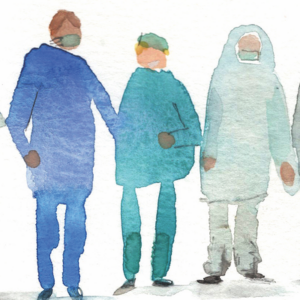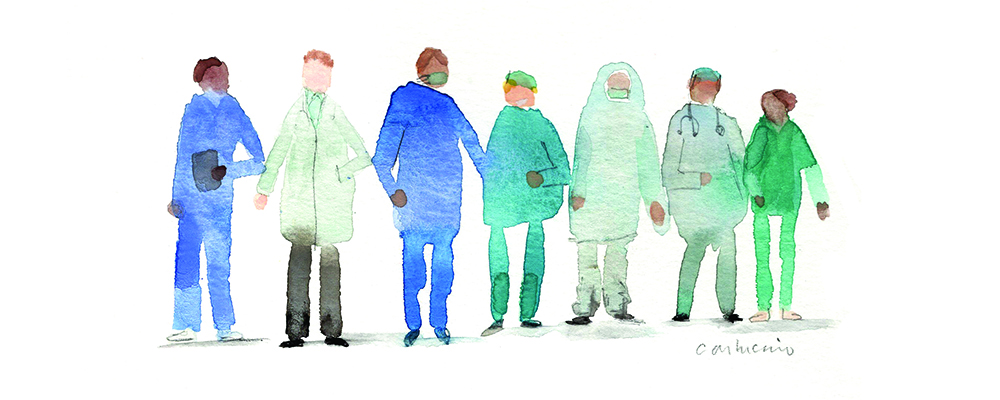 Pandemic Lessons: A nurse in the nation’s capital
Pandemic Lessons: A nurse in the nation’s capital
By Rose Conklin
Illustration by Maria Carluccio
The end of March, April, we were getting hit hard with COVID in Washington, D.C. It was really still an unknown illness, but it was everywhere. I had started a float position as a registered nurse at George Washington University Hospital, working on the medical surgical units and in the ER, sometimes helping out ICU nurses, wherever they needed me most. I was on the COVID medical surgical floor a lot of shifts in those months. A lot of nurses were scared in the beginning — having to put on the PPE and wear a mask the whole day, not something we were used to doing before the pandemic.
Like many working with COVID patients, I was worried about my family — my partner and our daughter, who was three at the time. We were living in a one-bedroom, one-bath apartment. A doctor I worked with told me about someone with Airbnb in our neighborhood; she hadn’t been able to rent it out, and she wanted to help. Another nurse and I took her up on it. Deciding to move away from one’s family during a time like this is a very personal decision. We were there for five weeks.
I didn’t really see my family much during that time — because of concern that we could get COVID and be asymptomatic, then pass it on. It was hard, not seeing my daughter except through FaceTime and in a socially distant way. She couldn’t hug me, and I couldn’t hug her.
It was hard, not seeing my daughter except through FaceTime and in a socially distant way. She couldn’t hug me, and I couldn’t hug her.
By the end of those five weeks, I had gotten tested several times: nasally, through saliva, and through a study in the ER for antibodies. I came back negative for all. In May, my family moved together into a two-bedroom, two-bath apartment.
We were learning more about COVID, even though we were getting mixed signals from the CDC. That is frustrating, because the hospital makes changes based on those guidelines. For patients who were alone and not allowed visitors, it was hard. Some were depressed. In general, even before the pandemic, as hospital nurses, we spend most of the time with patients, and that was similar during the pandemic.

We were the main ones going in while on contact and airborne precautions. Doctors make decisions based on daily or as-needed in-person evaluations, and on the vital signs, blood work, and clinical observations that are obtained from nurses and techs. COVID patients can decompensate really quickly. You have to be aware of that. We had patients on continuous cardiac monitoring and continuous pulse ox. The concern for COVID is oxygen level going down too quickly. We were able to monitor that.
The ICU is where COVID patients were intubated. When a patient was really decompensating, they did the Hail Marys — including the meds like President Trump got, but also tPA, tissue plasminogen activator — a med for patients who have ischemic strokes, because COVID can produce clotting. There were patients getting 100 percent oxygen on ventilators, yet the patients’ oxygen level would be in the 60s or 70s for days. At that point, staff start to talk with the family; letting them come and look at the patient through the window in the door while a nurse puts a phone to the patient’s ear, even though they’re intubated and sedated.
What you need to get through it
Before the pandemic, I would talk to loved ones about the importance of hygiene. They would say, “Oh, that’s Rose — she’s a nurse, and she’s all about the hand washing!” Now they’re all about it.
I served with Peace Corps in Guatemala 2008–11, as a Healthy Schools Volunteer and then a Volunteer leader. We would travel to smaller schools to help with healthy habits: getting access to clean water, and education with teachers and mothers. The director and founder of the program was Sergio Mack, a pediatrician and public health specialist. He planted the seed of this public health community program some 10 years prior and saw it grow.
Right now this pandemic seems never-ending, but it is very temporary in the grand scheme of things.
Working with Peace Corps and interpreting with medical missions deepened my interest in healthcare. Back in D.C. I got a job working with a nonprofit organization focused on early intervention: visiting families with children under 3 who were getting physical therapy, occupational therapy, speech therapy. Often they were Spanish-speaking. It was like I had taken my world experience home. And I went to nursing school at Johns Hopkins, thanks in part to a Coverdell Fellowship.
I talked to my site mate from Peace Corps when the COVID pandemic was starting to ramp up. I told her that it was strange, but the isolation when I left my family kind of felt similar to the Peace Corps experience. It’s very different in another sense, being socially distant within the community. But similar in the sense of what you need to get through it: to be resilient, tenacious, hardworking, patient.
The months ahead
Right now this pandemic seems never-ending, but it is very temporary in the grand scheme of things. Just like Peace Corps, it’s one to two years of your life — depending on how it’s managed — and then it’s over. We can take away from that experience how to live a healthier lifestyle; it’s knowledge-building.
I got the first dose of the vaccine on January 4, and I plan to get the second dose on January 27. At the same time, after the holidays, we’re bracing ourselves for infections that might come before the vaccine kicks in. If it hits, what are we going to do?